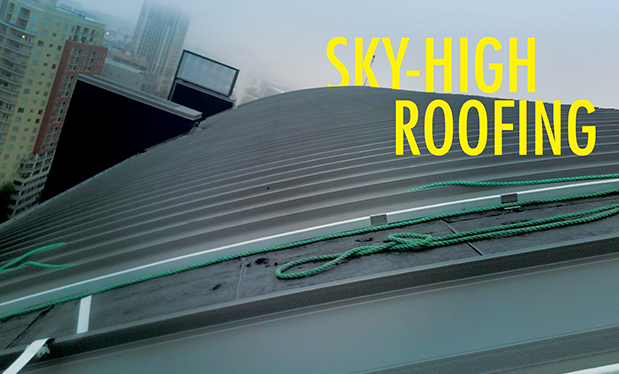Successful roofing contractors invest in a wide array of systems, such as payroll, inventory management and information technology, to keep their businesses growing. But though most roofing contractors appreciate the value of investing in systems to build their companies' infrastructures, some overlook how selling and installing a branded roof system can help them achieve more sales.
It can be challenging to explain to homeowners why they should invest in a branded roof system when competitors are quick to quote less expensive systems composed of components from several manufacturers, but learning how to do so can help grow your business.
What is a branded roof system?
Simply defined, a branded roof system comprises components that have been developed and documented by one manufacturer to work together. Talking about a home's roof in terms of a system is a simple, straightforward way roofing professionals can explain to homeowners how the different parts of a roof system work together to protect their homes.
It can be challenging to explain a branded roof system in a way that makes sense to homeowners when some customers would rather focus on the "fun stuff," such as shingle colors, or the bottom line on the estimate. A good place to start is by using words that explain what a roof system does in terms homeowners will understand.
When it comes to discussing how a roof system helps protect a homeowner's biggest investment, manufacturer Owens Corning Roofing and Asphalt LLC, Toledo, Ohio, has found three words consistently make sense to homeowners: seal, defend and breathe.
Seal, defend and breathe
At its core, the individual components in a branded roof system work together to help seal a home against the intrusive elements from Mother Nature, defend the home against the environment, and allow the home to breathe through proper ventilation and moisture management.
Following is an example of how a branded roof system's individual components can be described to homeowners. As you talk to homeowners about these components, they will be able to understand how these parts work together to function as a whole roof system.
Seal
- Underlayment provides a second level of defense against the elements while protecting the roof from damage and moisture. The underlayment also serves as a critical component for attaining a Class A fire classification for a roof assembly with asphalt shingles.
- Self-adhering membranes provide a high level of ice and water defense, sealing vulnerable areas where water and ice can wreak havoc on a home's roof.
Defend
- Hip and ridge shingles are designed to bend over the roof's contours to defend against wind while protecting roof peaks and enhancing the overall aesthetics of a home's roof.
- Starter strips seal on the first-course shingle, enhancing wind performance and providing a quick installation of the roof's outer components.
- Shingles are what most homeowners think about when they consider a new roof. Shingle selection often is the fun part of the presentation as homeowners consider the wide range of palettes, textures, color gradations and dimensions available.
Breathe
- Ventilation is important because all homes breathe, and a properly ventilated roof not only helps a home improve airflow, but it also defends against heat and moisture damage generated by daily activities within a home. A properly ventilated attic includes air intake and exhaust vents to help control airflow, prevent mold growth, manage attic temperatures and help mitigate ice damming.
Differentiate your company
In particularly competitive markets, selling branded roof systems can help differentiate your roofing company from competitors and position you as a credible, go-to expert in the market.
NRCA member M&M Home Remodeling Services, Crete, Ill., is a full-service exterior contracting company serving the greater Chicago area since 1976. The company employs 85 full-time employees year-round and 110 employees during its peak season. Sixty-five percent of the company's business comes from the residential sector. Nick Yadron, the company's president, says selling branded roof systems has benefited his company.
"It's helped my company improve our closing rate and has increased revenues," he says. "It's added more value to what our customers purchase compared with contractors who compete based primarily on price."
Some homeowners—particularly those who view roofing as a commodity—can be cynical of a contractor who offers a roof system as opposed to the "shingles" the customer specified. Yadron and his team have fielded questions from customers who received estimates from other roofing contractors selling on a component-by-component basis.
"When we go in and talk about the Owens Corning Total Protection Roofing System, we have heard customers ask, 'Why isn't anyone else bringing this up?' or 'Why are you guys the only ones telling me I need this and talking about a system?'" he says.
Yadron responds to these customers by associating his company's longevity with its commitment to being at the forefront of innovative solutions and systems.
"We explain the system we recommend is a progressive approach," he says. "We let customers know this is one of the reasons M&M Home Remodeling Services is still serving customers after 40 years."
Engage your customers
In his conversations with homeowners, Yadron says he focuses on showing a homeowner the roof system. There is wisdom in the old adage "a picture is worth a thousand words," and Yadron incorporates plenty of visuals in his presentation. He uses a series of slides as a starting point to talk through the branded roof system components, but he doesn't stop there. Daylight permitting, Yadron also takes the homeowner outside to see the roof system on his or her house.
"We'll go out and look at the homeowner's house, or even a neighbor's house, so the homeowner understands how the parts work together and why we're making certain recommendations," he says. "For example, we'll look at the ventilation in an attic and talk about why it's important to balance airflow, internal temperatures and comfort in a home."
Yadron says seeing a neighbor's house is particularly well-ventilated occasionally is the factor that makes a homeowner want to ensure his or her home has the same level of quality ventilation.
Yadron also invites homeowners to handle roofing materials during his presentation. The durability of the materials helps build homeowner confidence when choosing a branded roof system. Ultimately, Yadron says this high level of interaction during the presentation builds credibility for his business, positioning the contracting sales representative as the trusted expert.
"We're not selling a component or a job," he says. "We're offering the homeowner a level of security and confidence that is backed up by the manufacturer and the contractor."
Justin Sudduth, owner of I-Roof-CA, Anaheim, Calif., has grown his business serving primarily residential customers and also uses a systems-driven approach. According to Sudduth, when customers are engaged in seeing the process of how branded roof systems are designed to protect the integrity of their homes, price rarely is the overriding factor in the decision about which roof system to select. In fact, he says his business achieves 30 to 50 percent higher sales by demonstrating how a branded roof system works versus individual components.
"Customers get excited as they go through the process of seeing a roof system virtually built in front of them," he says. "Customers see that sometimes the cheapest roof [in the long run] may be the most expensive [upfront]."
Region and climate matter
Of course, even the best sales process or most-effective branded roof system will not deliver optimal results if it does not take a home's climate into account. When selling a roof system, you should consider the regional climate and even historical building practices characteristic of the area.
For example, homes in Southern California's dry, arid climate often were built with wood shake shingles. As new shingles were installed over uninsulated, plywood-covered attics, air could become trapped and stagnant. Consequently, the interruption in airflow could lead to improper ventilation and contribute to other problems such as mold formation.
"Homes were meant to breathe, and a properly specified and installed roof system facilitates proper airflow," says Sudduth. "Here in California, we have a lot of uninsulated or underinsulated homes, and in addition to addressing ventilation in the attics, there is an opportunity to talk about how insulation can serve as a solution to encapsulate key areas."
A win-win approach
Yadron and Sudduth agree selling branded roof systems can set a roofing professional apart from the competition while helping grow a business and improving customer satisfaction. In addition to more sales and better service, Sudduth says branded roof systems can even help elevate the perception of the industry.
"We're working in an industry where there is a tremendous amount of liability and risk every day, yet we're still perceived as being 'old school,'" he says. "When we talk about roof systems, we're showing the knowledge that goes into recommending a home's roof that protects a homeowner's home. In the long run, selling branded roof systems will affect our industry in a positive way."
Susan Miller is a consultant and writer with 5MetaCom, Carmel, Ind.



